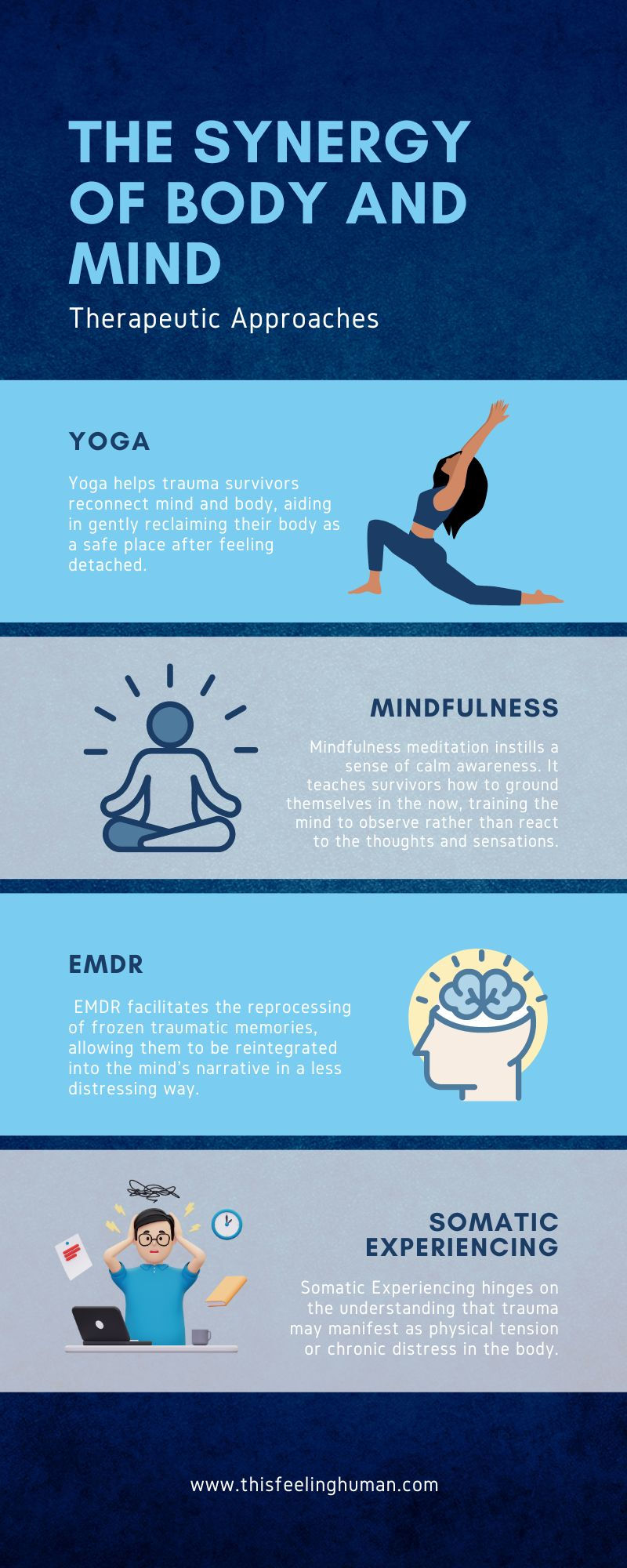Pathways to Healing | Embracing Body-Centered Therapies (EMDR)
- TFH

- May 15, 2024
- 5 min read
Updated: Aug 7, 2024
EMDR therapy introduces a fascinating concept: that the mind can heal from psychological trauma just as the body recovers from physical trauma. Through rhythmic eye movements guided by a therapist, individuals can reprocess traumatic memories, reducing their emotional intensity. It's akin to the natural healing process experienced during REM sleep, allowing for a cleansing of distressing memories.
Synergy of the Body and Mind
Today, we explore the core principles of each alternative therapy and its profound impact on trauma.
Four Therapeutic Approaches
Yoga: Reestablishing Connection and Ownership of the Body

Yoga serves as a bridge reconnecting the mind and body. Trauma survivors often report feeling detached from their bodies; yoga helps them gently reintegrate, reclaiming ownership and recognizing their body as a safe place. The practice of yoga, with its focused breath and movement, allows one to engage with trapped emotions physically, promoting healing from the inside out.
Mindfulness: Creating Safety in the Present Moment
Mindfulness meditation instills a sense of calm awareness. It teaches survivors how to ground themselves in the present, training the mind to observe rather than react to thoughts and sensations. This practice is particularly helpful in managing hyperarousal—a common aftermath of trauma. By anchoring one's attention to breath or other sensory experiences, mindfulness fosters a safe space within the ever-present moment.
EMDR: Helping the Brain Reprocess Traumatic Memories
EMDR is a unique therapy, that uses bilateral stimulation to mimic the psychological state of REM sleep—a time when the brain processes daily emotional experiences. EMDR facilitates the reprocessing of frozen traumatic memories, allowing them to be reintegrated into the mind's narrative in a less distressing way. This can be profoundly liberating for someone whose life is overshadowed by the weight of past trauma.
Somatic Experiencing: Releasing Physical Tension and Trauma Trapped in the Body
Emotions are deeply intertwined with our bodily experiences, particularly when it comes to trauma. Somatic Experiencing underscores how trauma can manifest as physical tension or chronic distress within the body. This understanding reveals that our emotional responses are not isolated but are often accompanied by physical sensations that influence our overall well-being.
To address these issues, Somatic Experiencing promotes the development of bodily awareness and the use of grounding exercises. By focusing on these practices, individuals can gradually release the residual 'fight or flight' energy that their bodies could not discharge during the traumatic event. This process helps reduce the lingering impact of trauma on their current emotional experiences.
To support readers in managing their emotional and physical well-being, we’ve partnered with The School of Emotions to promote Emoli Cards, which enhances emotional literacy. Each emotion has its narrative, impulse, and purpose. Therefore, we offer Emotion-Based Coaching to provide a holistic approach to emotional well-being, incorporating Emoli Cards, Calm3D for mood regulation, and life coaching sessions to help clients address both the emotional and physical aspects of their experiences, fostering comprehensive healing and resilience.
Silent Erosion: Ignoring Your Inner Reality
In the quiet spaces of our minds, beneath the hustle of daily routines and the constant barrage of external stimuli, lies the essence of who we are—our inner reality. This sacred, often overlooked, domain holds the keys to our sense of self, our unique identity, and our deeper purpose in life. Yet, in today's fast-paced world, where productivity and external achievements are highly prized, we risk neglecting this inner sanctum, leading to a silent erosion of our very essence.
The Cost of Ignoring the Inner Voice
Our inner reality is punctuated by our thoughts, emotions, dreams, and intuitions—a complex tapestry that forms the backdrop of our existence. When we continuously ignore this internal landscape, prioritizing external demands and societal expectations, we strip away layers of our identity and sense of self. This neglect does not come without cost. The price is a gradual disconnection from our core, leaving us feeling hollow, unfulfilled, and without direction.
Identity in Crisis
By turning a deaf ear to our inner voices, we allow our identities to be shaped by the whims of the world around us. We become chameleons, constantly changing colors not to reveal our true selves but to fit into society's prescribed mould. This adaptive behavior, while sometimes necessary, can lead to an identity crisis. Who are we when the masks fall off, and we are left with the quiet of our own company?
Purpose Lost in Translation
Purpose—the guiding light of our existence—thrives on the nourishment of our internal dialogue. It is in the contemplation of our desires, strengths, and passions that we find our direction. However, when the noise of the external world drowns out this inner discourse, our sense of purpose becomes muddled. It's akin to being adrift at sea without a compass; we may move, but without direction, progress is an illusion.

The Path to Reconnection
Reconnecting with our inner selves is neither a luxury nor an act of self-indulgence. It is a necessity for authentic living. This reconnection requires deliberate action, a turning inward that can feel counterintuitive in a culture that glorifies the external. Yet, it is in this inward turn that we find the clarity and strength to build our lives on the foundation of who we truly are.
Cultivating Inner Awareness
The journey to reconnection begins with cultivating inner awareness. It involves creating spaces of silence and solitude where we can listen to the depths of our being. Practices such as meditation, journaling, and mindfulness serve as gateways to this inner sanctum, allowing us to explore and understand our thoughts, feelings, and desires.
Embracing Authenticity
As we become more in tune with our inner reality, the courage to live authentically grows. Authenticity is not about perfection; it's about embracing our imperfections and vulnerabilities and recognizing them as integral parts of our identity. It means making choices that resonate with our core, even if they go against the grain of societal expectations.
Finding Purpose in Being
In reconnecting with our inner selves, we uncover the wellspring of purpose that lies within. This purpose is not imposed from the outside but emerges naturally from our experiences, passions, and values. It is a purpose that aligns with our authentic being, offering a sense of direction that is both invigorating and deeply fulfilling.
Conclusion
Ignoring our inner reality may seem like a viable strategy in the short term, allowing us to navigate the demands of the external world with adaptive ease. However, in the long run, this neglect eats away at our sense of self, identity, and purpose, leaving us feeling adrift in our own lives. The path to wholeness and fulfillment is an inward journey—a path of cultivating awareness, embracing authenticity, and finding purpose in being. As we turn inward, we discover that the essence of who we are holds the key to living a life rich with meaning and direction. Let us not silence the inner voice that seeks to guide us home.

Comments